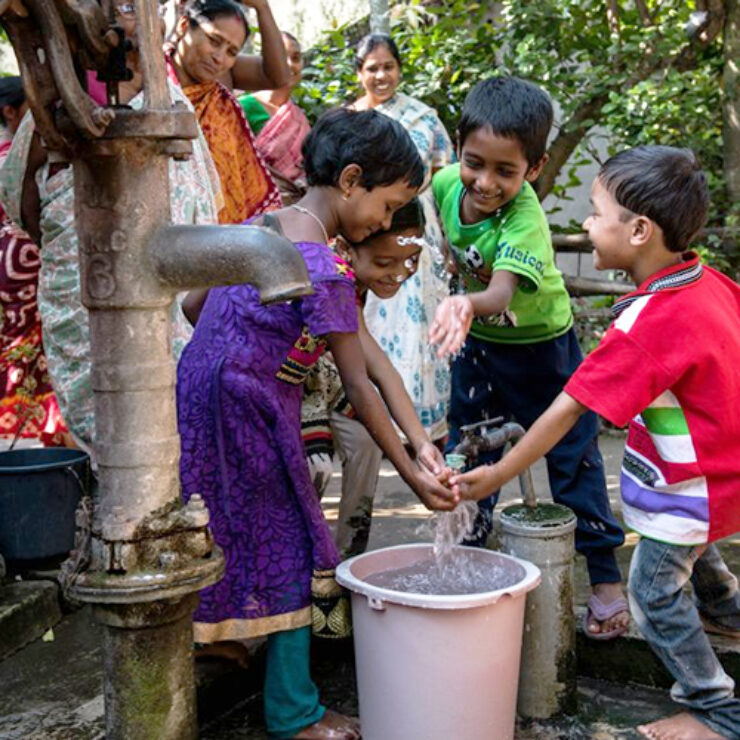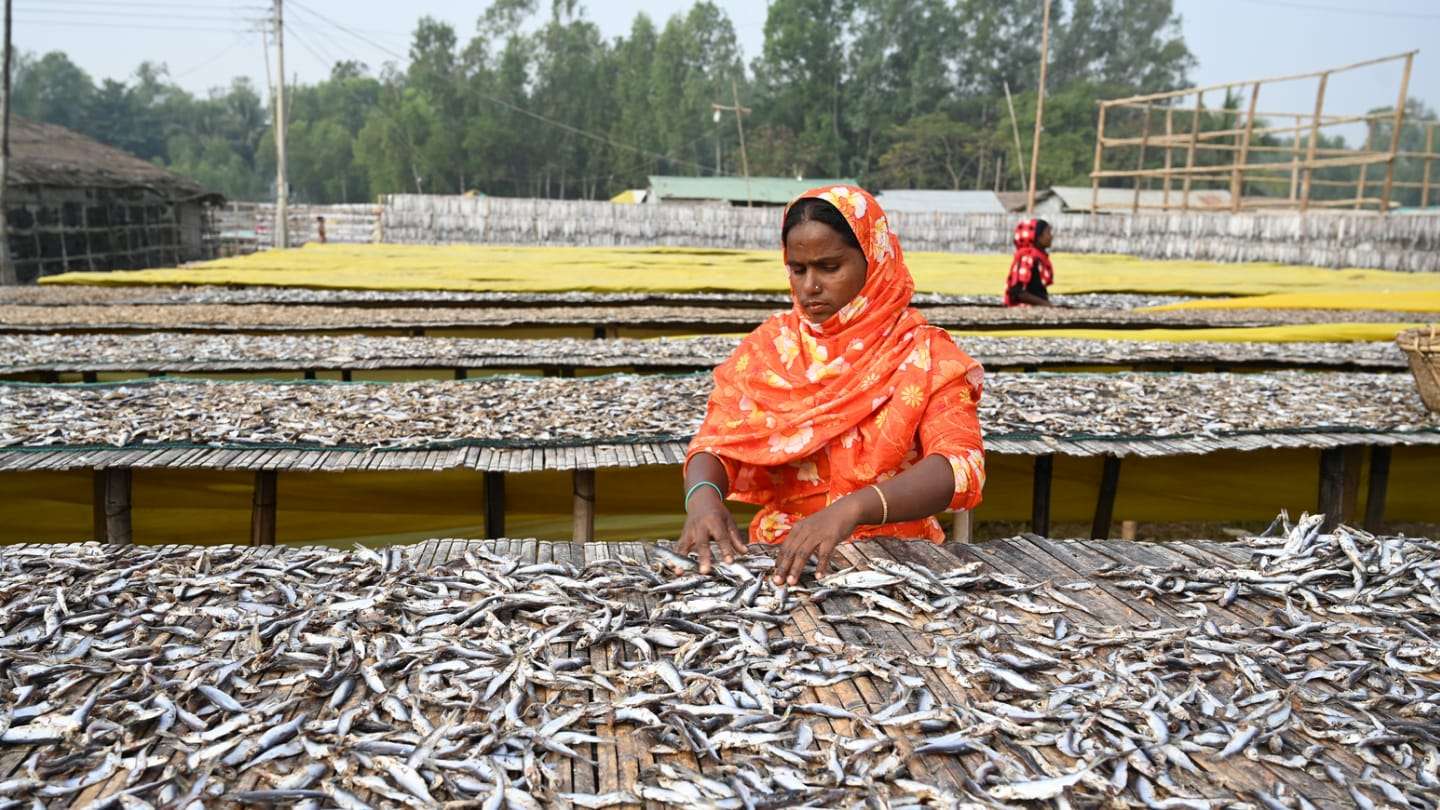
Job Market & Vocational Skills Assessment Study
Background
The local economy of Khulna relies heavily on agriculture and fishing, with over 34.9% of the population engaged in farming and about 11% working as wage laborers. Severe weather conditions such as cyclones, tidal surges, floods, and cold spells lead to unemployment, exacerbating seasonal food and job insecurity in terms of availability, access, and utilization of skills and resources. The region’s vulnerability to disasters, coupled with its remote location, hinders access to services in Upazila and District towns, further limiting employment opportunities in vulnerable coastal areas of Dacope, Koyra, and Khulna. It has been found that Koyra and Dacope have 29% and 24.9% of their population living below the extreme poverty rate. Khulna district is one of the trailing districts of Khulna Division with an HCR (head count ratio) of 30.8% living below the poverty line compared to division average of 27.5%.
On that note, Inspira Advisory and Consulting Limited has been commissioned to conduct a Job Market & Vocational Skills Assessment Study by Concern Worldwide. The goal of this research was to evaluate both macro and micro-level industry dynamics and the purpose of the assessment was to understand the current existing employment opportunities (self- and waged), and what are the local skill gaps in the target areas in the country’s selected 12 priority industry sectors on a priority basis.
Objective of the Study

Key Findings
Current employment scenario in Khulna and future growth prospects
Before the 1990s, Khulna experienced significant economic growth due to factors such as becoming a district headquarters in 1961, leading to rapid industrialization with industries like jute mills and textile mills. Infrastructure development, including a substantial increase in road networks, improved transportation of goods. In 1984, Khulna gained city corporation status and a railway connection, further boosting its role as a business hub in the Khulna division. These developments created over 30,000 jobs, raised income levels, and improved the quality of life. Support industries and transportation services also thrived, while the 1990s witnessed a cluster of industrialization growth, transforming Khulna from a rural area to a bustling economic center, attracting rural-to-urban migration.
From 2005-2021, Khulna saw a decline in industrialization and economic activities due to factors like the shutdown of state-run mills and factories, worker strikes, and corruption. Inadequate disaster resilience led to a drop in agricultural activity, and other regions reduced their dependence on Khulna. The COVID-19 lockdown further exacerbated economic challenges, causing significant job losses, particularly among women-led enterprises. In Khulna city alone, around 20% of businesses closed between March and July 2020, leaving 20,000 people unemployed, with 15,000 more at risk due to subsequent waves of the pandemic. Overall, the economy and employment in Khulna have been negatively affected.
Other declining factors are as follows:
- Migration of population from Khulna to other regions. As per reports, 18,000 people per year migrate from Khulna to other districts in search of employment.
- Those who lost jobs moved to other available lower income jobs thus creating massive pressure on other employment options. Others who couldn’t find jobs moved to their villages to pursue already declining agriculture.
- Employed population in supporting services such as retail stores, restaurants, transportation lost business due to income decline of the population.
- Services dependent on factories and other regions lost work leading to pay cuts as well as job loss.
The employment scenario of the entire Khulna district has been presented by the graph below which states that almost a large number of the people are involved in agriculture which accounts to 34.90%. Businesses and service holders have the second and third largest market share for employment in the entire Khulna region. The percentages are 19.60% and 18.27% respectively. From the graph a certain thing to be noticed is that only 3.51% of the employment is industry oriented. This is an indication that the entire region is not yet heavily industrialized or mechanized, therefore providing us a hint that the population requires skill for industry related works such as machine operators, workers, monitors etc.
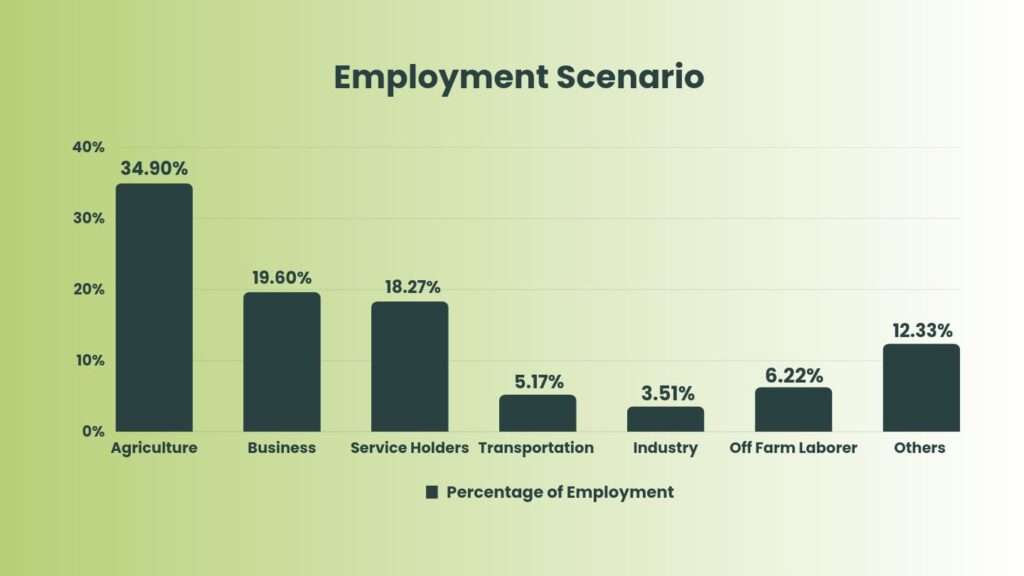
To know the industry types that are currently operating in Khulna and its sub-urban regions of Khulna, the actual percentages of the types of industry (micro, macro, small, medium, cottage and large industries) are also illustrated for the better scenario. From the graph, it could be seen that the largest type of business run is the cottage industry (1.5 lakh cottage business). To the contrary, the Khulna has only 144 con-current large businesses/enterprises.The Total people engaged (TPE) in business types and the male to female ratio in the employment in Khulna has also been described in the following charts.
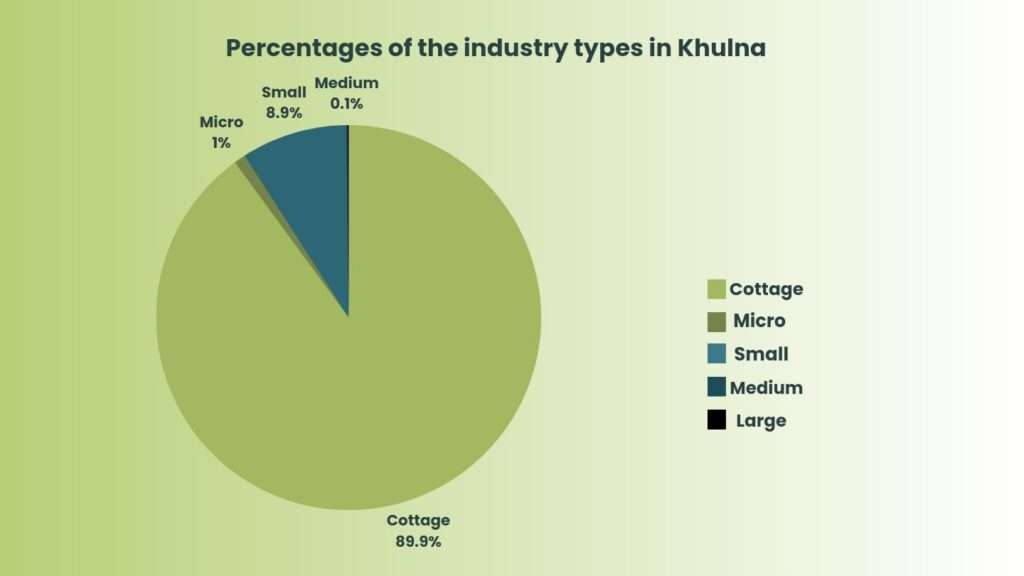


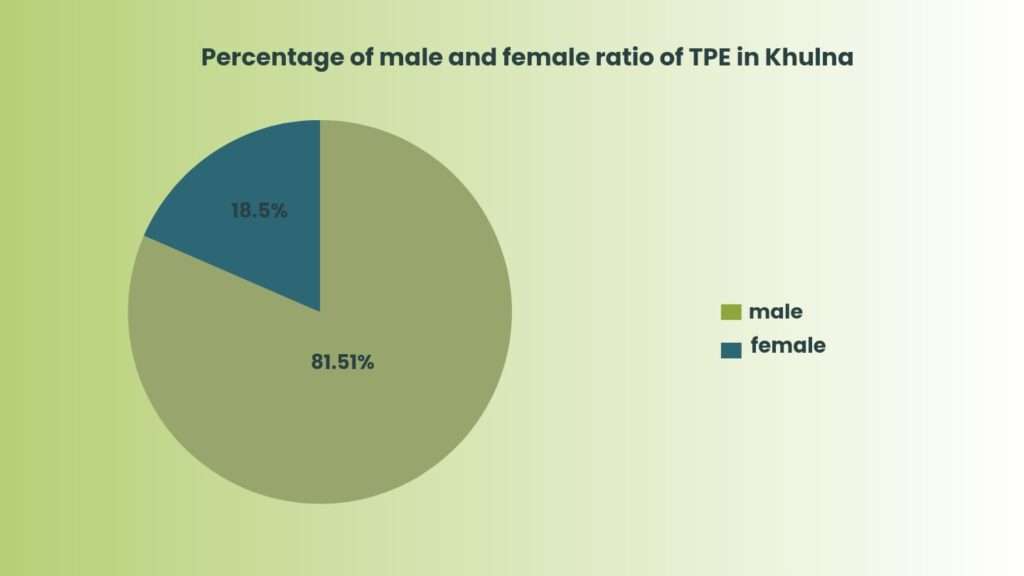
Predicted growth in Employment Opportunities
Emergence of New Businesses – The recently constructed roads and highways such as the Jessore road are predicted to bring new businesses to the region.As per the previously stated completion of 10 new roads , the sideways of the new roads have already seen the emergence of road side businesses and food courts. This has not only created employment but has influenced numerous IGAs including toys and handicrafts selling, roadside snacks and vending, etc. Furthermore, Khulna is set to become a hub for tourism as Sundarbans become easily accessible for tourists owing to construction of new roads and bridges. The biggest tourism centered business revolves around hospitality and tourism in the Khulna region since, Radisson Hotel Group and Grand Hotel and Hospitality Limited had jointly planned to set up a new luxury hotel in Khulna that features 150 rooms which is scheduled to open in 2023. (Tb News) Industry insiders predict that with the emergence of large businesses will bring in smaller support businesses which will complement the economy.
Creation of New Jobs – When the research team interviewed the district administration department, the team noticed that the future of Khulna will come with various employment opportunities. From the head office of the Khulna District Department of administration. The possible employment requirements and growth areas are construction, consumer electronics, transport mechanics in the nearest future of Khulna and its sub-urban areas. The establishment of new hotels will create job opportunities for housekeepers and will require a huge scope for the hospitality sector, where hotel managements, chefs and other vocational skilled youths will be highly required. Not only this, the growth of the tourism industry with better roads and highways, Padma bridges while also requiring employment in the tourism sector as tourist guides, experts etc. As the growth of retail stores will increase in the regions for various reasons mentioned above, this will create job opportunities for the prospective salespeople too.
Details of current local understanding of basic labor rights and the concept of ‘decent work’ and how the project can support this
When Inspira ANC’s study team was conducting multiple interviews to understand how the employment labour market and the ecosystem grasps the basic labour rights and decent work conditions as the per the ILO standardization, The responses were varied on a wide range and the KAP on the standardized working laws, environmental conditions, legal attributes and rights of the labour were not so clear to both the hiring ends and the labour pools.
When asked about the concept of the “decent” work and the subsistent factors defining the key factors of decent work which are: 1) Presence of job contract 2) Absence of child labor 3) Presence of specific work schedule 4) Overtime 5) Presence of separate washrooms for female 6) Presence of firefighting system 7) Presence of waste management system 8) Presence of child friendly space for working mothers.
Understanding of basic labor rights and decent work varied significantly based on work experience and educational background of the participants and employers. Large number of the new employees, youth and the potential labour force from the interviews failed to understand the key factors and were not successful to claim that these factors are well abided by the workplaces of Khulna, Koyra and Dacope.
Snapshot of the TVET(Technical and Vocational Education and Training) Institutes
Our research team visited 18 TVET institutes across Khulna City, Koyra, and Dakop to assess their offerings. Notably, there are no active institutes in Dakop, and only two in Koyra providing short courses. Out of the 18, 13 offered short courses and were the focus of our research, utilizing an 8-factor framework to evaluate their landscape. These factors encompassed infrastructure, ecosystem, trainer quality, inclusivity, job placement support, curriculum customization, remote training centers, and corporate governance.
The Institutes currently providing short courses are mostly in the Khulna City area. With only 2 exceptions being Koyra Computer Institute and Professor Training Institute, which are both based in Koyra. While these institutes are relatively small and lack job placement support, they are willing to collaborate to expand their offerings and accommodate Persons with Disabilities (PwD) and female participants. In Khulna City, institutes vary widely, with some offering diverse courses and excellent infrastructure, while others, though smaller, have potential as partners in developing the Khulna District’s workforce.
Factors influencing the gender roles in the employment of youth
The gender roles and norms play a huge part in the employability and the economy of any region, and Khulna is no exception. The following considerations which affect the training, development and employment of specific genders are norms, perception and opportunities and entry barriers based on gender of the workers. The findings regarding the women and employment factor have been categorized and added in details in the following sub segments of the report:
Norms: It dictates that women’s primary roles are homemaking and child-rearing, discouraging them from seeking employment or training outside the home. Religious conservatism and patriarchal dominance persist, limiting women’s participation to small in-home income-generating activities like sewing, selling handicrafts, or making seasonal items.
Youth’s perception of women participation in the workforce: From the perspective angles, the common trends of the youth are once again simple and based on the fact that females are not allowed to work outside the home. The opportunities for the women are very less since the constricted ideas of the overall idea of the regions for the women workforce participation is very narrow and not much open.
Employer’s perception of women participation in the workforce: Employers are reluctant to hire women due to the belief that they are less committed, face family-related interruptions, pose safety concerns in industrial fields, and require additional resources for workplace inclusivity.
Recommendation
1.How Training Service Providers (TSPs) can support the aspirants
Micro-entrepreneurs
For the newly trained youth the broader problem for start-ups are mostly three things: the incubation phase, the market linkage unawareness and the inability to access finance for their businesses. Before diving into the critical concerns and areas, one of the core things that the TSPs should delve into before giving entrepreneurial trainings are the following pints
- TSPs should be asked to ensure basic business courses are properly disseminated
- Course facilitators and TSPs should be able to monitor/identify interested candidates who have potential to become entrepreneurs
- There should be internal business idea pitch sessions to select the capable individuals to understand the scope of the entrepreneurship
Incubation period : Suggested Course of Action:
- During the incubation phase the participant can be taught on basic business skills
- Certain business model toolkits can be transferred in the mode of incubation workshop by training business model canvas specialists
Market Linkage: Suggested Course of Action:
- Connect with the key backward and forward linkage market actors by organizing cross discussion workshop, linkage workshops
- Product/service mapping in the area to help the participants to identify the right partners
- Connect with the key technical personnel from GoB, NGO etc.
- In case of cross region expansion, identify the potential buyers/lead firms and connect
Access to finance: Suggested Course of Action:
- Seed funding is key: There should be a trade wise basic business start-up grant allocated for the entrepreneurs
- Once the business starts there might be need for working capital and other forms of investment: Local Banks & MFIs can be connected through linkage workshops
- Connecting with existing accelerators with thematic focus: Swisscontact’s LES/furniture accelerator under bSkillful 2. These will help the entrepreneurs to grow their network which is highly required for the new small business to grow immediately and earn enough revenues to grow further.
- Partnership with small businesses for Apprenticeship
The new trainees and youth require apprenticeship and skills which cannot be provided from the learning centers. The general working experience is still not provided to the inexperienced youth and thus they lack multiple organizational skills which needs to be addresses
Inspira ANC is recommending to introduce a new way of apprenticeship as the:
Apprenticeship Model – The apprenticeship model is based on practical training at a Business. Trainees learn about a certain work by working at the business. The apprentice acquires knowledge of business as well as the trade skills through apprenticeship.
-These groups of collaboration can also be a hub for discussion of relevant soft skill dispersion: financial/savings skill, how to spot GBV cases, how to report CM or GBV to the right authority, impact of dowry etc. at a community level.
Suggested Course of Action:
Step 1 – Business Selection Criteria: A set of criteria has to be developed in order to select a business as an apprenticeship provider.
Example of some criteria are,
- Years of Experience: The business needs to have at least 5 years of business experience.
- Has to have proper hygiene facilities
- Has to have proper work environment
- Interest to work with female participants
- Interest to join meetings/discussion sessions
- Basic education
Step 2 – Theoretical components cannot be disregarded, should be facilitated by experts who can do at least weekly 1 theoretical class
Step 3: There should be community level groups/leaders who can ensure that any feedback from participants is properly communicated (workplace harassment, social tantrum etc.).
- Ensuring the concepts of decent work & workplace safety protocols are well-understood by the participants
Suggested Course of Action:
Awareness: TSPs should ensure that the participants and trainees are well versed with the decent work key indicators. The key indicators are:
- Presence of job contract
- Absence of child labor
- Presence of specific work schedule
- Overtime Compensation
- Presence of separate washrooms for female
- Presence of firefighting system
- Presence of waste management system
- Presence of child friendly space for working mother
Training Integration: The key indicators of Decent Work and Workplace Safety protocols should be integrated into the curriculums. The training and the entire ecosystem of employment should be made aware of gender equality and decent work and hygiene environments etc. throughout the course period.
Follow-up: TSPs should be able to place the employees at facilities with the right conditions. Follow up with the facilities to ensure that the working conditions are being maintained. The gradual improvement of the working conditions needs to be monitored as well.
- How to address the social stereotypes of gender roles
Current Scenario of Perceived Gender Norms in Top 20 Trades | |||
Gender Norm | Trade | Gender Norm | Trade |
| Only Males | Mobile Phone Servicing | Male & Female both | Food processing |
| Male & Female both | Food & Beverage Service | Only Females | Dress Making & Tailoring |
| Only Males | Electronic Home Appliance Repair | Only Females | Block Boutiques and Printing |
| Only Males | Motorcycle Mechanics | Only Females | Beauty Care |
| Only Males | Plumbing | Bpth Male & Female | Salesmanship |
| Only Females | Housekeeping | Only Males | Welding |
| Only Males | Electrical House Wiring (EIM) | Only Males | Masonry |
| Only Males | Refrigeration and Air Conditioning repair | Only Males | Driving cum Auto Mechanics |
| Only Males | Computer Applications | Only Females | Handicrafts (Fashionable Products making) |
| Only Males | Tiles Fitting | Only Males | Industrial Sewing Machine Operation & Maintenance |
Suggested Course of Action:
- As per the previous stated recommendations, repeated community based Uthan Baithaks and courtyard sessions conduction from Concern Worldwide is a necessary step to bring the community-based perception of gender roles in the society to encourage more participation of women in the training.
- Trainings can ensure the safe transportations specifically to the women participants so that the distant traveling is not a factor for the trainees from for example: Dacope to Khulna Sadar
- How to utilize the influx of new digital leaders
New digital leaders in e-commerce, recruitment services and other in-formal service providers are expanding to the Khulna region and will be launching operations by early 2022. This bodes well for the numerous skilled potential employees who have not been able to make use of their learnings due lack of knowledge and opportunity. Collaborating with these new digital leaders will allow the workforce to find a more dynamic and fluid medium to find job opportunities in a more consistent and easier to understand manner.
Suggested Course of Action:
All of this new influx of trades combined creates a unique demand for employees with hybrid trade skills. Utilizing this opportunity, Concern worldwide can become a medium between these new employers and the TSPs to communicate the employers needs and develop curriculums the TSPs can follow to meet this Hybrid skilled workforce demand within the Khulna region. This can be achieved in the following manner –
- One key thing that the TSPs can do in order to create more employment opportunities is to partner up with ‘blue-collar job matchmaking platforms’: Kormo Jobs by Google, Workindo for construction workers etc.
- Customized curriculums can be developed based on market demand coming from the new employers launching operations in Khulna
- Relevant skill development modules and training sessions can also be given to the target beneficiaries given the upcoming Hi-tech parks and sectors will be absorbing a number of young talent centric individuals residing in the suburban areas near the centers.On


